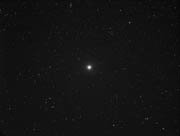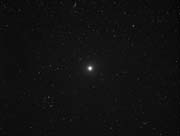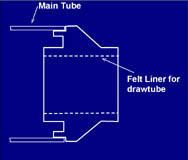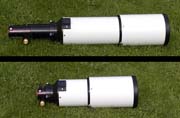|
MUCH later!
As the years passed and I gradually acquired
CCD cameras with larger sensors, it became evident that
the field of the instrument was not flat enough for
successful imaging - stars towards the edges and corners
were badly distorted. In July 2015 I resolved to 'do or die'
and on browsing the 'net, I found a solution - a
non-reducing field flattener from Teleskop Service.
This
one. Duly purchased direct from TS (at the time the Euro
was low, so cheaper than buying in the UK!), it proved to do
the job admirably, thereby saving the otherwise excellent
telescope from probable sale, and at the same time giving me
a medium field imaging option.
It is necessary to space the flattener correctly as noted
on the TS web page, but although TS are able to supply
custom made extensions, I was able to make suitable parts on
my small lathe, a useful saving! These before and after
images were taken using my QSI683 CCD camera with a chip
size 18 x 13.5 mm. The bright star is Deneb. Click on the
thumbnails (flattened is the lower one) for larger images.
Full size corner crops are here.
As a bonus, the flattener also improves the images using
my Meade 127 refractor, although that is quite good without
the flattener.
|


|




